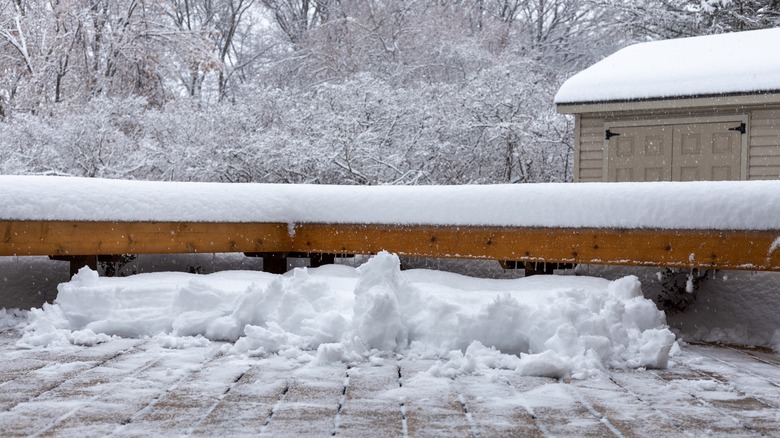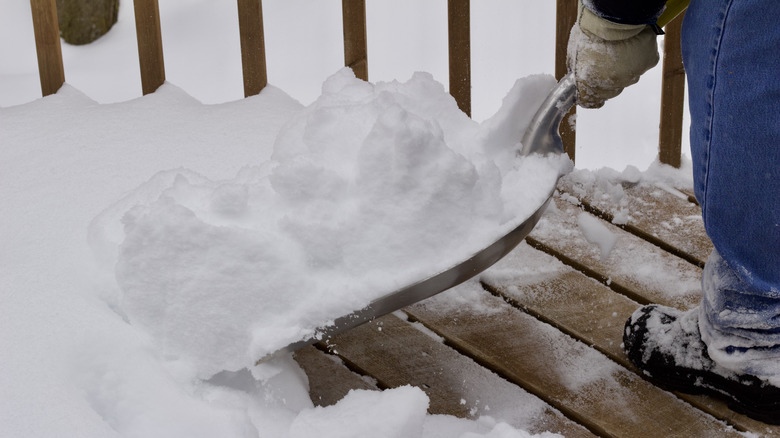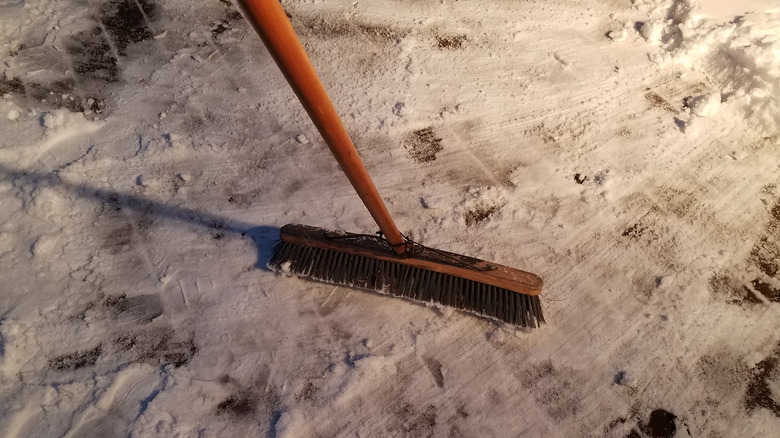Shoveling Snow From Your Deck: Necessary Or Waste Of Time?
The long-awaited arrival of winter brings cold weather, pretty snowflakes, and cozy evenings spent inside. Unfortunately for homeowners, it often results in shoveling, and lots of it. It also raises the question of whether you need to shovel your deck. The answer, like most things in life, isn't a simple yes or no. Sometimes shoveling your deck is unnecessary, but it depends on several factors, from how you use your deck to the depth of the snowfall.
In most cases, a sturdy deck can handle a typical snowfall just fine. Composite and maintenance-free decks are built to handle snow. Their design allows for drainage and melting, so shoveling is rarely needed. Wood decks that are well cared for, updated, and built to code can support significant weight even under snow. However, they do best when a water-resistant seal has been added prior to snowfall — a simple way to protect your deck for winter. So, unless you're buried in several feet of fluff, let the sun do its work. Melting snow won't harm your deck, and you'll save valuable time. However, there are certain situations when shoveling your deck is indeed necessary.
Situations in which you do need to shovel your deck
Any time the snow reaches the height of your deck railing (typically around 3 feet), particularly if snow obscures your deck railing, it's time to grab the shovel. Snowdrifts higher than the railing pose a safety hazard, especially for children or seniors. Clear a path or remove enough snow to keep the railings visible. This heavy accumulation can block emergency exits and put pressure on the deck's structure. It's a good idea to prioritize clearing a path for safe access and focus on steps and railings. Shovel a path wide enough for safe passage in case of emergencies.
On a more lighthearted note, sometimes shoveling can be a matter of personal preference. If you are craving a winter BBQ on your deck or simply want to gaze at the stars or the snow, clear it. Leaving snow on your deck for extended periods can trap moisture and create icy patches, making enjoying your outdoor space more treacherous if snow and ice persist for days.
Tips to shovel your deck wisely
If you decide to shovel, do it right to avoid unnecessary wear and tear on your deck, and start with using the right tools. Ditch the metal shovel and opt for a plastic or rubber-edged shovel to prevent scratches. A push broom will work for light snow and is even gentler. For smaller snowfalls (less than a foot), a leaf blower is a handy hack to handle snow and works wonders. These tools remove the snow without risking damage to your deck. Save your shoveling energy for the driveway and walkways.
Also, be sure to shovel parallel to the deck boards, not across them. This reduces scraping and potential damage. Never pound the shovel into ice in an attempt to dislodge it because that can damage the boards. Of course, safety should always come first, so dress warmly, wear gloves and boots, and take breaks to avoid exhaustion or injury. Be mindful of icy conditions on the deck and around the steps. Push rather than lift heavier snow to avoid straining yourself.
Proceed with caution when using chemical deicers, as some can damage decks. For example, deicers that contain calcium chloride are fine for composite decks, while those that are made with sodium chloride can damage wooden decks. Use them sparingly, focusing more on walkways leading to your deck, and opt for pet-friendly options if needed. Of course, you can also let the sun handle the snow, especially if it's light.



